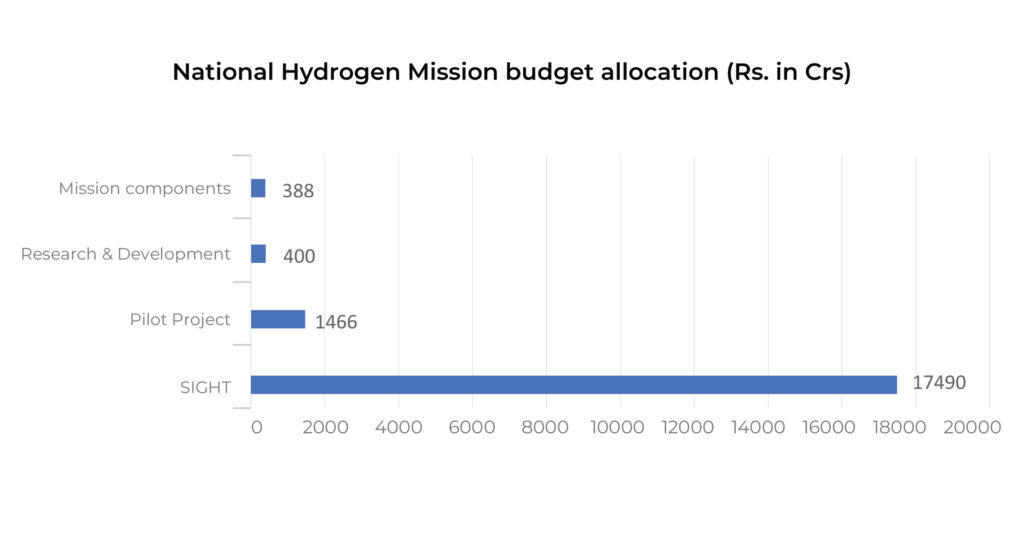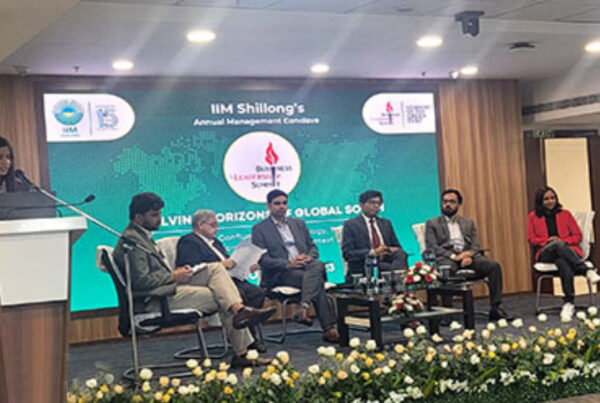India is the world’s third-largest consumer of energy, with 80% of the demand being met by coal, oil and solid biomass. Energy use has doubled in the last 20 years and is expected to grow over 25% by 2030. India currently imports more than 40% of the primary energy requirements, costing the exchequer about USD90billioneach year. This has necessitated the need to shift to renewable sources of energy and progressively reduce the reliance on fossil fuels.
In line with this, the Hon’ble Prime Minister set India’s vision through a theme: Lifestyle for Environment (LiFE). The Union Budget 2023 captured it by focusing on seven priorities, of which one is ‘green growth’.
The National Green Hydrogen Mission was launched recently with a budgetary allocation of INR19,744 crore announced in the Union Budget for 2023-24. The mission’s main objectives are to:
- Make India the global hub for the production, use and export of green hydrogen and its derivatives;
- Push for green hydrogen to significantly decarbonize the economy and reduce fossil fuel imports; and
- Enable the country to assume technology and market leadership in green hydrogen.
The budget supports India’s aim to be a leader in technology and manufacturing of electrolysers and other enabling technologies for green hydrogen. The planned annual production target is 5 MMT per annum by 2030, with the potential to reach 10 MMT per annum on growth in export markets.

*SIGHT- Strategic Interventions for Green Hydrogen Transition program
Some of the targeted sector-wise initiatives are given below:
- Replacing fossil fuel sources with green hydrogen in ammonia production and petroleum refining
- Blending green hydrogen in city gas distribution systems
- Undertaking steel production with green hydrogen
- Using green hydrogen-derived synthetic fuels (including its derivates like green ammonia, green methanol, etc.) in mobility, shipping, and aviation sectors, among others
Some salient features of the budgetary allocation for financial and technical support of green hydrogen are:
- SIGHT: The government proposed two distinct financial incentive mechanisms, with an outlay of INR17,490 crore up to 2029-30, to support the manufacturing of electrolysers and offer incentives for green hydrogen production. Depending upon the markets and technological developments, specific incentive schemes and programs will continue to evolve.
- Pilot projects: The government announced support for pilot projects in emerging end-use sectors and production pathways like low-carbon steel projects(green steel, outlay of INR455 crore up to 2029-30), mobility projects (INR496 crore up to 2025-26), and shipping pilot projects (INR115 crore up to 2025-26). Other targeted areas are decentralized energy applications, hydrogen production from biomass and hydrogen storage technologies, etc. In recent years, pilot projects have been undertaken for the production of green hydrogen through electrolysis of water using renewable electricity and biomass.
- Infrastructure: Support for regions capable of large-scale production and/or utilization of hydrogen shall be identified and developed as green hydrogen hubs at an initial outlay of INR400 crore up to 2025-26.
- Ports: Development of infrastructure to export green hydrogen derivatives, and pipelines to facilitate bulk transport and intermediate storage of green hydrogen and its derivatives. The government aims to promote the adoption of hydrogen/derivatives (ammonia/methanol) as propulsion fuel for ships and shall provide necessary support for making India a green hydrogen/derivative refueling hub. Necessary power infrastructure for delivery and use of renewable energy will be undertaken to provide an ecosystem for large-scale green hydrogen production.
- R&D projects: Public-private partnerships for R&D of competitive technologies (Strategic Hydrogen Innovation Partnership – SHIP) shall be facilitated under the mission. A dedicated R&D fund would be created through contributions from industry and respective government institutions.
- Skills development: A coordinated skills development program for local talent is under discussion.
- Projects: New refineries and city gas projects have been planned and designed to be compatible with maximum green hydrogen deployments, with the goal of progressively replacing imported fossil fuels.
Outcomes for the Indian economy
- Developing green hydrogen production capacity of at least 5 MMT per annum with an associated renewable energy capacity addition of about 125 GW
- Total investments of over INR80 lakh million
- Creation of more than six lakh jobs
- Cumulative reduction in fossil fuel imports (over INR10 lakh million)
- Abatement of nearly 50 MMT of annual greenhouse gas emissions
- Becoming a leading producer and supplier of green hydrogen across the world
- Creation of export opportunities for green hydrogen and its derivatives
- Lower dependence on imported fossil fuels and feedstock
- Development of indigenous manufacturing capabilities
- Attract investments and business opportunities for the industry
Opportunities for Indian companies
As the global consensus towards net zero is gathering momentum, the demand for green hydrogen and its derivatives is set to rise. Asymmetries in anticipated demand and production capabilities for green hydrogen in different countries and regions are likely to drive international trade in green hydrogen and its derivatives, like green ammonia and green methanol. This represents a unique opportunity for India to capitalize on its abundant renewable energy and land resources, and become the market leader in green hydrogen and its derivates. There is a mass deal of favorable impacts on a number of associated sectors on account of the growth of green hydrogen. To name a few:
- Electrolyser manufacturers
- Iron and steel producers
- Refining companies
- Bulk chemicals and fertilizer manufacturers
- Maritime and shipping entities
- Mobility/transport companies
- Refueling station operators
- Renewable energy (solar, wind etc.) generators
The team at AGR Knowledge can help you evaluate opportunities for your company and identify partners to take an informed decision and formulate an optimized approach for your business in the green hydrogen economy. For more information, connect with Shreeya Palekar, Assistant Manager.




